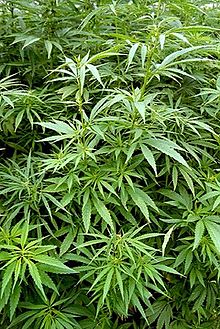Cannabicyclol
| Structural formula | ||||||||||
|---|---|---|---|---|---|---|---|---|---|---|

|
||||||||||
| General | ||||||||||
| Non-proprietary name | Cannabicyclol | |||||||||
| other names |
(1a R - (1aα, 3aα, 8bα, 8cα)) - 1a, 2,3,3a, 8b, 8c-hexahydro-1,1,3a-trimethyl-6-pentyl-1 H -4-oxabenzo [ f ] cyclobut [ cd ] inden-8-ol ( IUPAC ) |
|||||||||
| Molecular formula | C 21 H 26 O 2 | |||||||||
| External identifiers / databases | ||||||||||
|
||||||||||
| Drug information | ||||||||||
| Drug class | ||||||||||
| properties | ||||||||||
| Molar mass | 314.46 g mol −1 | |||||||||
| safety instructions | ||||||||||
|
||||||||||
| As far as possible and customary, SI units are used. Unless otherwise noted, the data given apply to standard conditions . | ||||||||||
Cannabicyclol (CBL) is one of the many representatives of naturally occurring cannabinoids and has no psychoactive effects.
Occurrence
CBL has so far only been discovered in hemp ( Cannabis sativa and Cannabis indica ). It is a metabolic product of the hemp plant and is produced in glands on the surface of the plant (like cannabinol , for example ). CBL can develop when cannabichromes are exposed to light , among other things . The occurrence of CBC is higher in cannabis indica than in cannabis sativa .
Web links
- CTD's Cannabicyclol page from the Comparative Toxicogenomics Database
- Compounds found in Cannabis Sativa . In: Erowid . (English)
- Marijuana and cannabinoids (THC, CBD, CBN ...)
Individual evidence
- ↑ This substance has either not yet been classified with regard to its hazardousness or a reliable and citable source has not yet been found.
